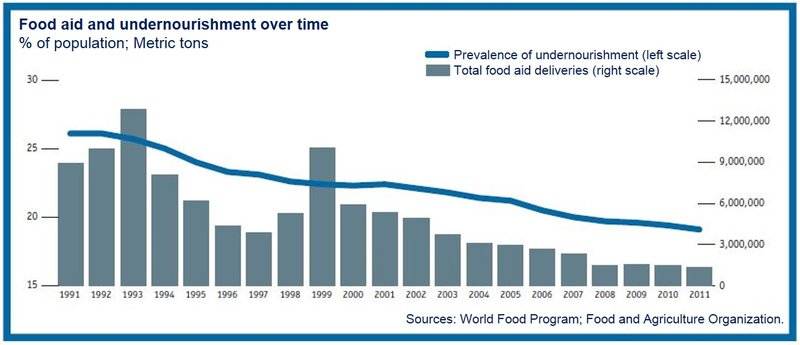Bad weather, geopolitical problems, plus a 7.5% rise in cereals prices led to a fall in food security in almost 70% of nations in Q1 2014, says The Economist Intelligence Unit’s Global Food Security Index.
The Global Food Security Index is commissioned by DuPont to facilitate dialogue on food security. It is a yearly report and evaluates the availability, affordability, and quality of food in a total of 107 nations. The Index is adjusted every quarter to reflect the effects of global food price changes on each country’s food security.
The adjustment gained 3.4% in Q1 2014 compared to Q4 2013.
Food prices rose
Leo Abruzzese, Global Forecasting Director for the Economist Intelligence Unit, said:
“Food prices jumped in February and March as the political crisis in Ukraine, an important grain producer, worsened. We haven’t seen much in the way of actual supply disruptions yet, but market prices move quickly on any hint of risk. Food prices have also been pushed higher by dry conditions in some key growing regions around the world.”
According to the Food and Agriculture Organization (FAO), part of the United Nations, in Q1 2014, food prices globally rose to their highest level in almost a year.
The Global Food Security Index (GFSI) produced the following findings, after making adjustments for price changes, exchange rate movements, national incomes and import dependence on a country-by-country basis:
Food security – for two-thirds of all countries, in Q1 2014 rising world food prices drove down food security. In comparison to Q4 2013, GFSI affordability scores declined by 0.3% (average), while overall food security scores fell by 0.1%. Costa Rica, which experienced the greatest fall, saw its affordability score drop by -4.1% and overall food security by -1.6%.
Cereals and sugar prices – increased the most in Q1 2014 versus Q4 2013, by 7.5% and 8.1% respectively. This was mainly due to poor weather conditions in key producing nations across Latin America, Southeast Asia and the United States.
Droughts affected wheat, corn and sugarcane production
The western region of the US had serious droughts, which resulted in lower wheat and corn exports. Further droughts in Brazil and Thailand pushed up the price of sugarcane.
Meat, on the other hand, fell by nearly one third of one-percent in the FAO’s Meat Price Index – the only food commodity not to rise in price in Q1 2014.
Geopolitical concerns – corn and wheat prices have increased, partly because of the problems in the Crimea region, a major exporter of the two cereals. Tensions between Ukraine and Russia remain high.
Food affordability – declined in several Sub-Saharan and LAC (Latin American & Caribbean) nations. Seven countries in the two regions experienced particularly steep declines. In Haiti, Colombia and Costa Rica food affordability was caused by unfavorable exchange rates, and by declining incomes in Guinea, Niger, South Africa, and the Republic of Congo.
Globally, Ukraine faced the greatest fall in food affordability.
In North Africa and the Middle East, food affordability improved, with the exception of Jordan, Saudi Arabia and Egypt, which reported declines.
Global food insecurity, a slow process
Today, over 870 million people worldwide do not have a secure source of food. Leaders at the World Food Summit met in Rome in 1996 and set a target of reducing the number of people living without a secure source of food to 400 million.
This target will be missed. Over the last 20 years, only 2.5 million people annually have emerged from food insecurity.
(Source: Global Food Security Index)
However, although the problem is vast, particularly in the lower- and middle-income economies, enormous gains have been made, mainly through the alleviation of poverty and innovations that improve market access, boost the availability of more nutritious crops, and raise a family’s ability to buy food.
The G8 group of nations in 2009 pledged $22 billion in aid in response to the global food crisis of 2008. (G8 members include Canada, France, Germany, Italy, Japan, the Russian Federation, the United Kingdom, and the United States.) However, by mid-2013 less than half of the promised funds had been disbursed.

